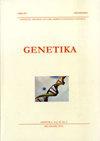玉米自交系向温带优质蛋白玉米(GPM)的标记辅助转化
4区 农林科学
Q3 Agricultural and Biological Sciences
引用次数: 0
摘要
由于缺乏必需氨基酸,如赖氨酸和色氨酸,玉米对人类和单胃动物来说都是蛋白质的不良来源。自然发生的不透明2 (o2)突变增加了这些氨基酸的含量,但也赋予了不良表型导致低产量。优质蛋白玉米(QPM)是通过常规育种获得的农艺可接受和营养改良的不透明玉米。波兰玉米研究所(MRIZP)正在开展一项旨在开发适合温带地区生长的QPM基因型的标记辅助育种计划。本文的结果与前景选择有关,旨在鉴定4个MRIZP商业自交系在BC2F2代o2位点获得纯合子的植物。将适应温带气候的玉米自交系ZPL5转化为QPM亲本,作为4个循环亲本(RP)的氧供体。利用基因特异性标记phi057和umc1066进行前景选择,结果均符合预期。BC2F2代的隐性纯合子比例约为25% (RP1为24.6%,RP2为23.3%,RP3为25%,RP4为24.4%)。选择隐性纯合子自花授粉后,对BC2F3后代进行表型和生化特征筛选,确认其营养和农艺优势。胚乳修饰评分结果显示95%以上的胚乳为硬胚粒。RP1的平均色氨酸含量为0.070% ~ 0.087%。在4个品系的39个衍生品中,19个色氨酸含量高于QPM阈值(0.075%)。共选择了16个色氨酸含量最高的衍生物。他们的质量指数相对于复发亲本提高了2-46%。这些品系将为培育适应温带地区的QPM玉米杂交种提供重要的育种材料。本文章由计算机程序翻译,如有差异,请以英文原文为准。
Marker assisted conversion of maize inbred lines to quality protein maize (GPM) adapted to temperate climate
Maize is a poor source of protein both for humans and monogastric animals due to the lack of essential amino acids, such as lysine and tryptophan. Naturally occurring opaque2 (o2) mutation increases content of these amino acids, but also confers an undesirable phenotype leading to low yields. Quality protein maize (QPM) is agronomically acceptable and nutritionally improved opaque2 maize obtained through conventional breeding. Marker assisted breeding program aimed at developing QPM genotypes for growing in temperate regions is being conducted at Maize Research Institute Zemun Polje (MRIZP). The results presented in this paper relate to foreground selection aimed to identify plants that attained homozygosity at o2 locus in BC2F2 generation in conversion of four MRIZP commercial inbred lines. Maize inbred line ZPL5 converted to its QPM counterpart and adapted to temperate climate was used as o2 donor to the four recurrent parents (RP). Foreground selection was carried out with gene-specific markers phi057 and umc1066, both segregating as per the expectation. The percentage of recessive homozygotes in BC2F2 generation was approximately 25% (24.6% in RP1, 23.3% in RP2, 25% in RP3 and 24.4% in RP4). After the self-pollination of selected recessive homozygotes, BC2F3 progenies were screened for phenotypic and biochemical characteristics to confirm their nutritional and agronomical superiority. The results of scoring endosperm modifications revealed over 95% of hard endosperm kernels. The average tryptophan content ranged from 0.070% in RP1 to 0.087% in RP3. Out of 39 derivations from four lines, 19 had tryptophan content above the QPM threshold (0.075%). A total of 16 derivations were chosen for their highest tryptophan content. Their quality index was increased by 2-46% relative to the recurrent parent. These line will serve as an important breeding material for developing QPM maize hybrids adapted to temperate regions.
求助全文
通过发布文献求助,成功后即可免费获取论文全文。
去求助
来源期刊

Genetika-Belgrade
AGRONOMY-GENETICS & HEREDITY
CiteScore
1.80
自引率
0.00%
发文量
1
审稿时长
6-12 weeks
期刊介绍:
The GENETIKA is dedicated to genetic studies of all organisms including genetics of microorganisms, plant genetics, animal genetics, human genetics, molecular genetics, genomics, functional genomics, plant and animal breeding, population and evolutionary genetics, mutagenesis and genotoxicology and biotechnology.
 求助内容:
求助内容: 应助结果提醒方式:
应助结果提醒方式:


